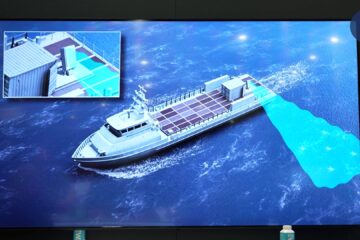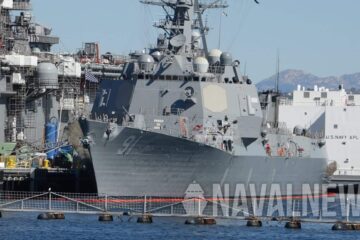Oshkosh Defense press release
As part of the demonstration, a Navy Marine Expeditionary Ship Interdiction System (NMESIS) launcher, based on a ROGUE Fires chassis, successfully launched a Naval Strike Missile (NSM) and scored a direct hit on a target at sea.
SINKEX is a component of the U.S. Navy’s Large-Scale Exercise (LSE) 2021, a global event in which Sailors and Marines test and validate the Navy and Marine Corps’ operating concepts.
ROGUE Fires is an unmanned ground vehicle (UGV) that leverages the JLTV’s extreme off-road mobility and payload capacity and Oshkosh’s advanced autonomous vehicle technologies to support Ground-Based Anti-Ship Missile (GBASM) operations. The unmanned technology associated with ROGUE Fires allows the vehicle to operate in teleoperator or leader-follower modes, which protect Warfighters from threats by removing them from the vehicle entirely.

“ROGUE Fires was purpose-built and leverages next-generation capabilities from several proven Oshkosh Defense vehicle platforms and technologies.” “Much like the JLTV itself, ROGUE Fires is tailorable to the mission at hand. The flexible design allows for the integration of scalable weapon system payloads to offer the combatant commanders flexibility based on the mission’s requirements.”
Pat Williams, Vice President and General manager of U.S. army and Marine Corps Programs.
Since receiving the JLTV production contract in 2015, Oshkosh Defense has worked closely with leading weapon system manufacturers to integrate and test various weapon system payloads and levels of firepower onto the JLTV platform.
“The successful LSE demonstration validates the maturity of ROGUE Fires as a weapons platform and highlights its ability to add significant firepower and capability into the light tactical wheeled vehicle fleet.”
Pat Williams, Vice President and General manager of U.S. army and Marine Corps Programs.
-End-
About NMESIS

NMESIS combines the NSM anti-ship missile with a Remotely Operated Ground Unit for Expeditionary (ROGUE) Fires vehicle, produced by Oshkosh Defense
NSM is a multi-mission cruise missile designed to destroy heavily defended maritime and land targets; it is the U.S. Navy’s over-the-horizon weapon system for littoral combat ships and future frigate
As we reported previously, the USMC selection of Naval Strike Missiles from Raytheon was first announced in May 2019. The image released on August 18, confirmed that the USMC uses an unmanned variant of the Joint Light Tactical Vehicle (JLTV) known as “ROGUE Fires”, as the NSM launch platform. The same vehicles is used for rockets:
The NMESIS was test fired for the first time during a “November 2020 live fire event “ which we first mentioned back in February 2021.






